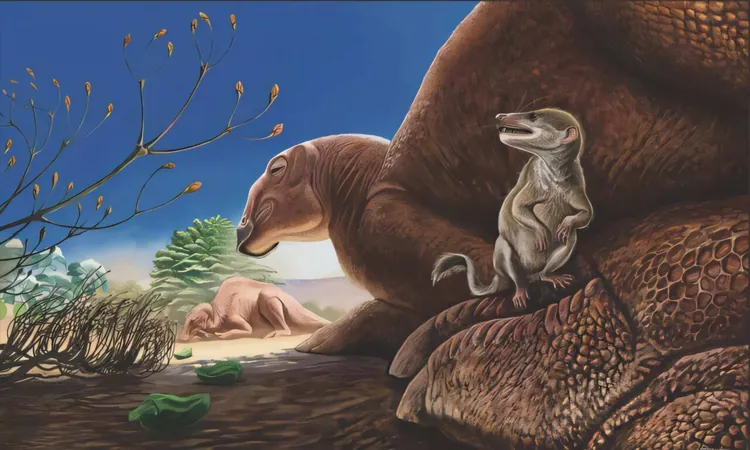
Tiny Jaw Fossil Unveils Ancient Fruity Mammal from the Age of Dinosaurs
2025-05-05
Author: Ming
A Stunning Discovery in Mongolia's Gobi Desert
The Gobi Desert in Mongolia has long been a goldmine for fossil hunters, unearthing monumental remains of dinosaurs. Yet, it recently revealed a smaller, yet equally groundbreaking find: a tiny jaw fossil of a previously unknown mammal that reshapes our understanding of ancient ecosystems.
Meet Ravjaa ishiii: The Prehistoric Fruit-Eater
The new mammal, named Ravjaa ishiii, hails from the Late Cretaceous period. Discovered in the Bayanshiree Formation, this species highlights early mammalian life thriving far removed from ancient coastlines.
The name Ravjaa ishiii pays homage to revered figures: 19th-century Buddhist monk Dulduityn Danzanravjaa and former director of the Hayashibara Museum of Natural Sciences, Kenichi Ishii. This shrew-like creature belongs to the now-extinct family Zhelestidae.
Unearthing the Jaw: A Unique Find
During a 2019 expedition, researchers stumbled upon a one-centimeter partial jaw encased in fluvial sandstone. This area, rich in small vertebrate fossils, had previously revealed limited mammalian specimens. The jaw, designated as MPC-M 100s/001, showcased distinctive zhelestid features alongside its own unique traits.
Dietary Secrets Encoded in Teeth
What makes this discovery even more fascinating is its dental structure. The molars of Ravjaa ishiii suggest a diet primarily based on grinding seeds and fruits, implying a frugivorous or omnivorous lifestyle—a stark contrast to many of its contemporaries, which were mostly insectivores. This dietary inclination coincides with the explosion of flowering plants during the Cretaceous Terrestrial Revolution, transforming ecosystems and food chains.
Jumping Back in Time: A Distant Relative
Phylogenetic analysis reveals that Ravjaa ishiii is closely related to the Zhelestinae subclade within Zhelestidae, yet stands out due to its lack of specific skeletal features and its exceptionally large molars. Its molar-to-jaw size ratio is the highest known in its family, cementing its status as a remarkable find.
New Insights into Ancient Habitats
The fossil's discovery in the Bayanshiree Formation, a fluvial environment, contrasts sharply with other known rich deposits that predominantly yielded multituberculates. It hints at a dynamic ecological setting where zhelestids could thrive, possibly indicating a preference for humid conditions compared to their relatives.
The absence of multituberculates in this region points toward reduced competition and a unique behavioral niche for Ravjaa ishiii.
A Window into the Past
Lead author Tsukasa Okoshi from Okayama University highlighted the significance of this find, emphasizing its potential to spur further taxonomic studies on small vertebrates from this era. "We aim to illuminate the diverse biodiversity that flourished in the Gobi Desert during the age of dinosaurs," he stated.
A Small Discovery with Huge Implications
Co-author Professor Mototaka Saneyoshi expressed the wonder of finding such a diminutive fossil in the vast desert, calling it "miraculous." The Ravjaa ishiii discovery doesn’t just add another name to paleontology; it pushes us to rethink mammalian habitats in the Late Cretaceous and underscores the critical role of even the smallest fossils in reconstructing ancient ecosystems.
Published in the journal Acta Palaeontologica Polonica, this study showcases how new findings continue to emerge from the Gobi Desert, steering our understanding of life on Earth during a pivotal era.

 Brasil (PT)
Brasil (PT)
 Canada (EN)
Canada (EN)
 Chile (ES)
Chile (ES)
 Česko (CS)
Česko (CS)
 대한민국 (KO)
대한민국 (KO)
 España (ES)
España (ES)
 France (FR)
France (FR)
 Hong Kong (EN)
Hong Kong (EN)
 Italia (IT)
Italia (IT)
 日本 (JA)
日本 (JA)
 Magyarország (HU)
Magyarország (HU)
 Norge (NO)
Norge (NO)
 Polska (PL)
Polska (PL)
 Schweiz (DE)
Schweiz (DE)
 Singapore (EN)
Singapore (EN)
 Sverige (SV)
Sverige (SV)
 Suomi (FI)
Suomi (FI)
 Türkiye (TR)
Türkiye (TR)
 الإمارات العربية المتحدة (AR)
الإمارات العربية المتحدة (AR)